Mastering 3D shapes: Faces, edges, and vertices worksheets for 4th Grade
-
Mastering 3D shapes in 4th grade is a huge step towards acquiring geometry skills now and in later grades. This article will discuss the main components of 3D shapes, i.e., faces, edges, and vertices. Also, we will introduce you to Mathskills4kids.com, an amazing website with fun educational worksheets, including faces, edges, and vertices worksheets for 4th Grade.
Whether your child is a visual learner or prefers hands-on activities, our diverse range of exercises caters to all learning styles. So, get ready to unlock your child's potential and watch them excel in 3D geometry with our captivating worksheets!
Become a 3D Shape Pro: Engaging Worksheets for 4th Graders to Master Faces, Edges, and Vertices.
Are you ready to help your 4th-grade student become a 3D shape pro? Then welcome to this amazing article full of engaging 3D worksheets from Mathskills4kids.com.
In these engaging worksheets for 4th graders, we have carefully crafted a range of activities to help 4th-grade students master faces, edges, and vertices.
From identifying these properties in various objects to constructing 3D shapes from 2D representations, our worksheets will captivate your child's interest and deepen their understanding of geometry.
Also, with a perfect blend of fun and educational content, these worksheets are meticulously designed to keep your child engaged while they learn.
-
BROWSE THE WEBSITE
-
DOWNLOAD FREE WORKSHEETS
-
-
4th GRADE MATH TOPICS
- Number sense
- Addition
- Subtraction
- Multiplication
- Division
- Mixed operations
- Variable expressions
- Functions
- Coordinate plane
- Data and graphs
- Logical reasoning
- Patterns and sequences
- Money math
- Units measurement
- Telling time
- Equivalent fractions
- Compare & order fractions
- Add & subtract fractions with like denominators
- Add & subtract fractions with unlike denominators
- Multiply fractions
- Decimals
- Add and subtract decimals
- Probabilities and statistics
- 2D shapes
- Triangles and quadrilaterals
- Symmetry
- Angles
- 3D shapes
- Geometric measurement
-
-
How do you identify three dimensional figures?
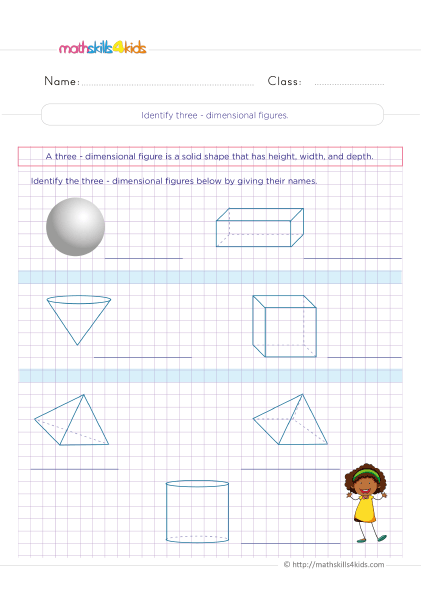 Print it...
Print it...
-
Counting verrtices, faces and edges of 3D figures
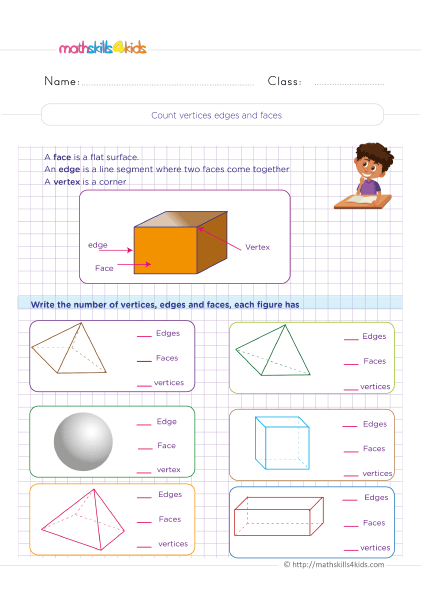 Print it...
Print it...
-
Which 2D shapes are seying on 3D shapes?
 Print it...
Print it...
-
Identifying faces of three dimentional figures
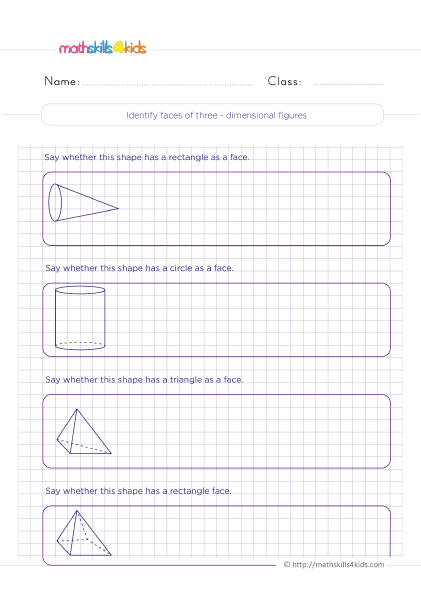 Print it...
Print it...
-
What are properties of three dimentional figures?
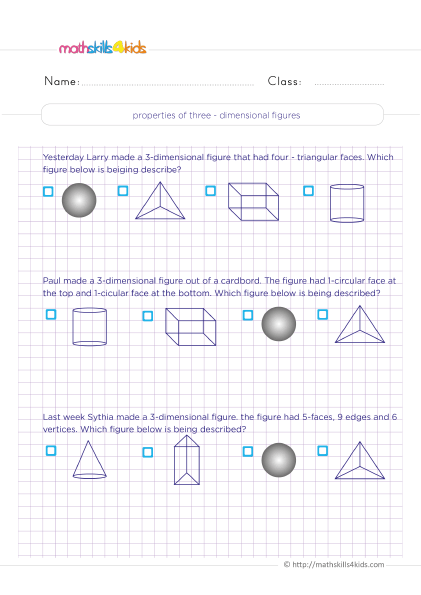 Print it...
Print it...
-
Understand nets of three dimentional figures
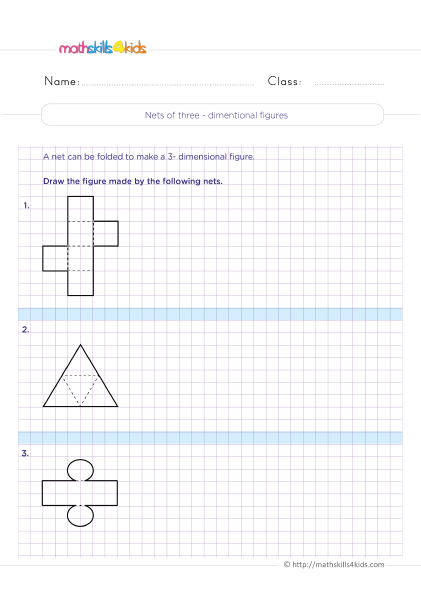 Print it...
Print it...
-
How do you identify three dimensional figures?
-
Buying is supporting us!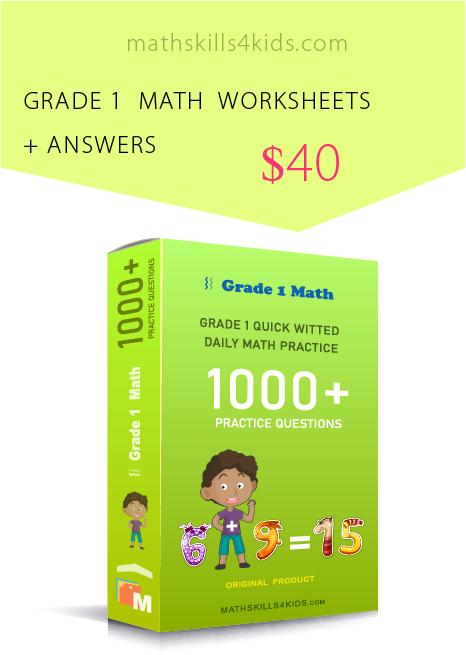
Buy Now...
-
-
Understanding 3D shapes: Faces, edges, and vertices
Understanding the fundamentals of 3D shapes is crucial for building a strong foundation in geometry. This section will explore the concepts of faces, edges, and vertices and how they contribute to defining various 3D shapes.
- Faces are the flat surfaces that make up a 3D shape. These surfaces can be polygons, such as triangles, squares, or rectangles, or they can be curved, like the surface of a sphere. By identifying and counting the faces of different 3D shapes, your child will become familiar with the unique characteristics of each shape.
- Edges are the straight lines that form the boundaries between the faces of a 3D shape. They connect the vertices and provide structure to the shape. Please encourage your child to trace the edges of different 3D objects to reinforce their understanding of this concept.
- Vertices are the points where the edges of a 3D shape meet. These points define the shape's corners or intersections. By counting the vertices, your child can distinguish between different 3D shapes and understand their unique properties.
To help your child grasp these concepts, our faces, edges, and vertices worksheets for grade 4 provide clear explanations and interactive exercises. Through hands-on activities and visual aids, your child will gain a deep understanding of faces, edges, and vertices, setting them on the path to mastering 3D shapes like pros.
-
Importance of mastering 3D shapes in 4th grade
Mastering 3D shapes in 4th grade is an essential milestone in a child's mathematical journey. Not only does it lay the groundwork for more complex geometry concepts in the future, but it also has real-life applications in various fields.
One of the key reasons for focusing on 3D shapes in 4th grade is to develop spatial reasoning skills. Understanding how objects exist and interact in a three-dimensional space is crucial for architecture, engineering, and design.
By mastering 3D shapes at an early age, your child will develop the ability to visualize and manipulate objects in their mind, an invaluable skill that will benefit them throughout their academic and professional lives.
Moreover, 3D shapes are all around us in the real world. Recognizing and understanding these shapes, from buildings to everyday objects, enhances a child's perception of their environment. By incorporating real-world examples in our worksheets, we aim to connect abstract concepts to the tangible world, making learning more relatable and meaningful for your child.
By helping your child to master 3D shapes in 4th grade, you are equipping them with essential skills that will pave the way for future success. Our engaging worksheets offer a structured and enjoyable approach to learning, ensuring that your child develops a solid foundation in geometry while having fun!
-
MathSkills4Kids interactive and engaging worksheets for learning 3D shapes
Learning should be interactive and engaging. That's why we have created diverse worksheets that cater to different learning styles and keep your child motivated and excited about geometry. This interactive and engaging way of learning 3D shapes includes:
- Visual puzzles, hands-on construction tasks, and interactive quizzes. With this variety of fun activities, these worksheets will ensure your child stays engaged and develops a well-rounded understanding of 3D shapes.
- Colorful illustrations and diagrams that visually represent the different aspects of 3D shapes. This worksheet is best for visual learners. It consists of visual aids that help your child connect the geometric concepts and their real-world applications, promoting a deeper understanding of the subject.
- Construction tasks where your child can build 3D shapes using materials such as paper or clay. This worksheet is excellent for those who prefer hands-on activities. By physically manipulating the shapes, your child will gain a tactile understanding of their properties, fostering a stronger grasp of the concepts.
- Interactive quizzes and puzzles. Our worksheets also include interactive quizzes and puzzles to reinforce learning and assess understanding. These activities challenge your child's knowledge and critical thinking skills, encouraging them to apply what they have learned in a fun and engaging way.
With our interactive and engaging Mathskills4kids’ worksheets, learning 3D shapes becomes an enjoyable and immersive experience. Your child will be motivated to explore, discover, and excel in geometry while having a great time!
-
Exploring different types of 3D shapes: Cubes, cylinders, spheres, and more
This section will delve into the fascinating world of 3D shapes and explore their various types and properties. From simple shapes like cubes and spheres to more complex forms like cylinders and pyramids, your child will gain a comprehensive mastery of 3D shapes.
- Cubes are one of the most basic 3D shapes, with six identical square faces. They have twelve edges and eight vertices. Please encourage your child to identify cubes in their surroundings, such as dice or building blocks, to reinforce their understanding of this shape.
- Cylinders are another common 3D shape, characterized by two circular faces and a curved surface connecting them. They have two congruent circular bases and a height. By examining objects like cans or rolls of tape, your child will learn to identify and differentiate cylinders from other shapes.
- Spheres are perfectly round 3D shapes with no faces, edges, or vertices. They are all around us, from balls to fruits like oranges and apples. By exploring the unique properties of spheres, your child will develop a deeper appreciation for their symmetry and simplicity.
- In addition to cubes, cylinders, and spheres, our worksheets cover a wide range of other 3D shapes, such as pyramids, cones, and prisms. Each shape is visually appealing and easily understandable, ensuring your child becomes familiar with their properties and can confidently identify them.
By exploring different types of 3D shapes, your child will develop a broader perspective on geometry and gain the ability to recognize and analyze shapes in their environment. Our worksheets provide ample opportunities for your child to explore and engage with these shapes, fostering a solid understanding of their unique characteristics.
-
Practice exercises for identifying faces, edges, and vertices
To build up your child’s 3D shapes, our worksheets include a variety of practice exercises for identifying faces, edges, and vertices. These exercises provide ample opportunities for your child to develop their skills in identifying and counting these properties in different 3D shapes.
- Identifying individual shapes. In this initial stage, this exercise focuses on individual shapes, allowing your child to become familiar with the characteristics of each shape
- Identifying the number of faces, edges, and vertices in cubes, cylinders, spheres, and other shapes. By identifying these properties, your child will build a strong foundation in the fundamentals of 3D geometry.
- Identifying faces, edges, and vertices. As your child progresses, the exercises become more challenging, requiring them to identify faces, edges, and vertices in composite shapes or objects of multiple 3D shapes. These exercises encourage critical thinking and problem-solving skills, as your child needs to analyze the given shapes and break them down into their components.
- Creating 3D shapes. To make the learning experience more interactive, some worksheets include cut-out templates that your child can assemble to create 3D shapes. By physically constructing these shapes, your child will better understand their properties and enhance their spatial reasoning skills.
Our practice exercises are designed to be engaging and thought-provoking, allowing your child to reinforce their understanding of faces, edges, and vertices in a fun and interactive way. With regular practice, your child will become a master of 3D shape identification!
-
Fun activities to reinforce understanding of 3D shapes
Learning should never be dull or monotonous. That's why we have incorporated fun activities into our worksheets to keep your child motivated and excited about geometry.
- "3D Shape Hunt." In this exercise, your child will embark on a treasure hunt around the house or classroom, searching for objects representing different 3D shapes. By identifying and categorizing these objects, your child will strengthen their ability to recognize 3D shapes in the real world.
- "Design a 3D Shape" challenge. Your child will be given a set of criteria, such as the number of faces, edges, and vertices, and they will be tasked with creating a unique 3D shape that meets these requirements. This activity encourages creativity and problem-solving skills while reinforcing their understanding of the properties of different shapes.
- Coloring activities where your child can bring 3D shapes to life. By coloring and decorating these shapes, your child will develop a deeper connection with the concepts and enhance their visual recognition skills.
These fun activities make learning enjoyable and provide opportunities for your child to apply their knowledge and think critically. By incorporating playfulness into the learning process, our worksheets ensure your child remains engaged and motivated to excel in geometry.
-
Incorporating real-world examples of 3D shapes in the worksheets
We understand the importance of connecting abstract concepts to the real world. That's why MathSkills4Kids worksheets incorporate real-world examples of 3D shapes to make learning more relatable and meaningful for your child.
- By including everyday objects like buildings, vehicles, and household items, we provide your child with a context in which they can apply their knowledge of 3D shapes. For example, your child may be asked to identify the 3D shapes in a city skyline or count the number of faces, edges, and vertices in a toy car.
- In addition to objects, our worksheets also introduce your child to famous landmarks and architectural marvels from around the world. By exploring structures like the Eiffel Tower or the Great Pyramid of Giza, your child will develop a deeper appreciation for the role of 3D shapes in shaping our physical environment.
By incorporating real-world examples, we aim to foster a connection between the concepts learned in the classroom and their practical applications. This approach enhances your child's understanding of 3D shapes and instills a sense of curiosity and wonder about the world around them.
-
Tracking progress and assessing mastery of 3D shapes
We believe in the power of progress tracking and assessment to ensure your child's continuous growth and improvement. That's why MathSkills4Kids.com plans to include built-in tools for tracking progress and assessing mastery of 3D shapes in their future worksheets.
Every worksheet contains a scoring system that allows you and your child to monitor their performance. By tracking scores over time, you can identify areas of strength and areas that may require additional focus. This information enables you to tailor your child's learning experience and provide targeted support.
In addition to tracking scores, our worksheets also include self-assessment exercises. These exercises encourage your child to reflect on their learning and evaluate their understanding of the concepts. By actively assessing their progress, your child becomes more aware of their strengths and areas for improvement, fostering a sense of ownership over their learning journey.
Our progress tracking and assessment tools are designed to empower your child and promote a growth mindset. By celebrating achievements and identifying areas for growth, your child will develop resilience and a desire for continuous improvement.
-
What you need to know about Mathskills4kids’ mastering 3d shapes worksheets Grade 4
Our Mathskills4kids website features interactive online games and activities that reinforce the concepts covered in our worksheets. These resources provide a fun and interactive way for your child to review and consolidate their understanding of 3D shapes.
We also provide a curated list of recommended books and educational videos that explore geometry and 3D shapes. These resources serve as valuable supplements to our worksheets, offering different perspectives and insights into the subject.
Furthermore, our website includes a dedicated forum where parents and educators can connect, share ideas, and seek advice on teaching geometry to 4th graders. This community of like-minded individuals provides a supportive environment for collaborative learning and growth.
Bonus: 3D shapes’ additional resources for further learning and practice
If you want to further your child’s 3D learning and practice, we have some additional resources here! These resources will complement our engaging Mathskills4kids’ worksheets and reinforce 3D shape mastering in 4th graders.
By offering these additional resources, we aim to provide a holistic learning experience for your child. We aim to empower them to excel in geometry and develop a lifelong love for learning.
- Math Worksheets 4 kids.com: This website has a huge collection of printable worksheets that will help you practice identifying, labeling, comparing, and analyzing 3D shapes. You can also learn how to construct new shapes from existing ones, draw nets and cross-sections of solid figures, and calculate the volume and surface area of 3D shapes. https://www.mathworksheets4kids.com/solid-shapes.php.
- com: This website has a variety of interactive games, guided lessons, and workbooks that will make learning 3D shapes fun and engaging. You can sort 2D and 3D shapes, identify 3D shapes in real life, experiment with rolling, sliding, and stacking different shapes, and much more. https://www.education.com/resources/3d-shapes/.
- K5 Learning.com: This website has free and printable geometry worksheets to help you review the basic concepts of 3D shapes. You can also practice your skills with angles, grids, and coordinate planes. https://www.k5learning.com/free-math-worksheets/fourth-grade-4/geometry.
-
-
Thank you for sharing the links of MathSkills4Kids.com with your loved ones. Your choice is greatly appreciated.
Conclusion
In conclusion, our engaging worksheets are the perfect tool to help your 4th grader master 3D shapes and become a pro. By mastering the concepts of faces, edges, and vertices, your child will develop a solid foundation in geometry that will benefit them throughout their academic and professional lives.
With a perfect blend of fun and educational content, our worksheets are meticulously designed to keep your child engaged while they learn. Whether your child is a visual learner or prefers hands-on activities, our diverse range of exercises caters to all learning styles.
Through interactive and engaging activities, our worksheets foster a deeper understanding of 3D shapes and their real-world applications. Incorporating real-world examples and fun activities makes learning relatable and enjoyable for your child.
So, prepare to unlock your child's potential and watch them excel in 3D geometry with our faces, edges, and vertices worksheets for 4th Grade.
